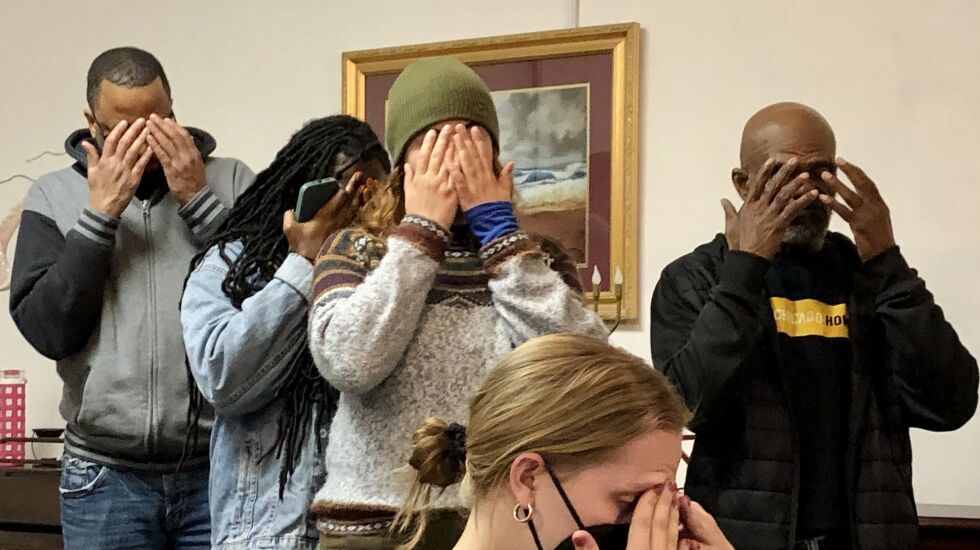
Mrs. Chris Brown, a lady of a certain age and that age is private, thank you very much, insists the honorific must be used before her name: “Mrs. Brown.”
”Everyone in North Lawndale knows me as ‘Mrs. Brown,’” she said, forcefully enough that, while I did make a stab at explaining the rigidities of newspaper style, for today it seems both prudent and polite that the rule book be set aside in recognition of a force greater than itself.

Mrs. Brown, elegant in a bright red jacket, butterfly pin and pink cancer awareness ribbon, came up to Chicago from Mississippi by way of St. Louis in the 1960s. She remembers contract buying, redlining and the way Blacks were jammed into tightly constricted areas where they were forced to occupy substandard apartments at jacked-up rents.
”Coming from the South, I got an apartment of my own,” Mrs. Brown tells a group of about 30 gathered for Sabbath dinner Friday night at the Stone Temple Baptist Church on West Douglas Boulevard.
“If I told you what that apartment looked like, nobody in this room would be believe me. It was in a six-unit building, an apartment designed for one family that was cut apart for multiple families. Our apartment was two rooms of that unit, the back part, which was a kitchen and a little bitty bedroom ...Filthy. Dirty dirty dirty. I mean, dirt like outside, that took me weeks to really clean. Got it clean. Got a job. Started to work. Went on from there.”
Including her current work to improve North Lawndale.
”Our goal now is to get homes where people can live with dignity and pride,” she said.
Attending a dinner in North Lawndale is not typical for me. But when confronted with a bit of surprising information — such as the fact that Jewish groups this year sponsored the building of Sukkahs, ritual booths for the fall harvest, in North Lawndale, an effort somehow connected to the large Jewish community that used to live there in the first half of the 20th century — there are two approaches a person can take.
You can immediately judge based on your own preconceived notions — I imaged these sukkahs being pressed upon uncomprehending residents, no doubt thanks to the transmission of money, as some kind of self-referential honor. If I had a program on Fox, maybe I would expand upon that notion, make fun of this obvious bit of urban colonialism, giggling and spraying derision based on my untested assumptions.
Or you can find out the actual situation, even if that involves driving to North Lawndale on an overcast Friday night and standing in a light rain among a group of three substantial sukkahs, set up across Douglas Boulevard from the church, each designed by an architecture firm.
My attention was immediately caught by a bright yellow effort.

“This one is going to be used for a farm stand,” said Alex Price, programming coordinator for the first Chicago Sukkah Design Festival. “It was designed by Human Scale, but all of them were designed with community input.”
Another is going to be a pop-up museum telling the history of the Stone Temple Baptist Church, and before the program began, I ducked inside for a look with Bishop Derrick M. Fitzpatrick. The building was originally a synagogue.
”It was the first Romanian congregation, so the Queen of Romania was here,” Fitzpatrick said. “Then in 1954, my grandfather, founding pastor of the church, bought this building and moved his church on the South Side here.”
All the original trappings, the Star of David stained glass windows and light fixtures are still in place.
”A lot of the Jewish symbolism: We didn’t think it was necessary, or even proper, to remove it,” he said.
They also kept a small podium with a long history.

”Martin Luther King Jr. was here,” said Fitzpatrick. “He set up headquarters here. Mayor Daley asked the African American preachers not to allow King to come. Ninety-eight percent of them didn’t. My grandfather was one of the first who did.”
Dinner was hot dogs and pizza and truly excellent, spicy challah from Masa Madre, an artisanal Mexican-Jewish bakery in East Garfield Park.
It was a diverse group of about 30: a third students from Avodah Jewish Service Corps, volunteers working “toward a more just and equitable world.” Plus representatives from various North Lawndale groups such as Shangwé Parker, from the North Lawndale Homeowners Association, who pointed out that, before the riots following King’s death, the community had 125,000 residents.
”We’re 30,000 now, and that’s including 4,000 people in the jail,” he said, outlining a plan to turn that around. ”We’re embarking on building a thousand homes here in North Lawndale.”
Added Charles Jenkins, of the Chicago Coalition for the Homeless, “By spring. we could be working to help build some affordable housing and wrap around services that come with the housing.”
So how is a sukkah celebration going to help?
”It brings light to our efforts, what we’re trying to do,” Parker said, explaining how they’ve raised millions in private money, matched by state grants. “We’re slated to start breaking ground hopefully in the next two weeks.”
I lingered after the dinner broke up, talking with Pastor Reshorna Fitzpatrick, Bishop Fitzpatrick’s wife. Isn’t this just more talk?
”Many things that have taken place are because people sat down and had conversations,” she replied. “I believe this is a conversation that will lead to great things. In this community, we’ve made lots of strides, when we get together, we learn, and are able to grow and build. I’m looking for this to be a bridge to something greater.”




!["[T]he First and Fifth Amendments Require ICE to Provide Information About the Whereabouts of a Detained Person"](https://images.inkl.com/s3/publisher/cover/212/reason-cover.png?w=600)


